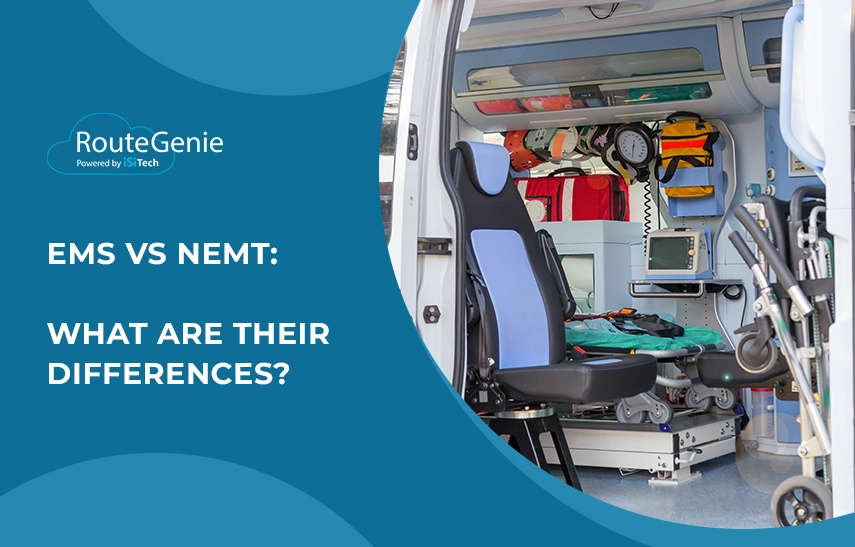EMS vs NEMT: What are Their Differences?

When people require transport to a medical facility, they have several options to choose from. However, some people don’t know the differences between the two main ones: emergency medical services (EMS) and non-emergency medical transportation (NEMT) services.
How are these options different when they both offer transport for people who need medical services?
Read on for a thorough breakdown of each service, who they cater to, and the difference between the services they provide for patients.
Contents:
- Emergency Medical Services (EMS) Explained
- Non-Emergency Medical Transportation (NEMT) Explained
- EMS vs NEMT: How Do They Differ?
- Takeaways. EMS vs NEMT: Similar but Different
Emergency Medical Services (EMS) Explained
Just as its name suggests EMS AKA emergency medical care is activated during incidents where people need first aid, immediate treatment and/or urgent transfer to a hospital facility. Whether the patient will be actually transported by the first responders or not, depends on the severity of the condition and distance to the hospital. In more remote or rural areas, where EMS resources may be limited and transport times to hospitals longer, there might be a higher proportion of cases where on-scene assistance suffices. In other cases ambulance sirens will be blaring and the patient will be rushed to a medical facility ASAP.
In any case, every person has become accustomed to the thought that when you dial 911 the EMS system will respond with help and reliable transport to the hospital if need be.
Non-Emergency Medical Transportation (NEMT) Explained

The realm of non-emergency medical transportation (NEMT) is less urgent, but just as important for the well-being of the community. It is used for all kinds of medical transportation, but mainly for situations that are not life-threatening. The most frequent users of this type of transport are the elderly, people with disabilities or simply those medical patients, who simply do not have a reliable way to make it to the doctor’s appointment on time.
Unlike EMS, the majority of NEMT providers do not operate traditional ambulances. Instead, their fleets are comprised of vans and buses specially equipped with aids for people with limited mobility. Through the years, more and more people have become reliant on NEMT and it is now essential for the healthcare system of any given region.
EMS vs NEMT: How Do They Differ?
Besides the obvious differences between these two transportation networks of the medical system, we would like to focus on the details of their distinction. They do have different goals, structures, processes and costs. See the details below.
Core Tasks of EMS and NEMT
EMS: It’s All About Emergencies
EMS is a coordinated response system designed to respond to medical emergencies. It involves many agencies, individuals, and organizations. Each component has a role in making EMS a seamless and capable response to any crisis.
These components include:
- Private and public medical facilities, agencies, and organizations
- Transportation networks
- Communication networks
- Highly trained professionals and volunteers
EMS providers work within the community, and it is part of their duty and responsibility to identify, inform, and respond to medical and health issues within that community.
The different EMS components work together with public safety and service agencies to ensure that emergency medical services are dispatched efficiently on a local or even national level.
NEMT: Vital Medical Transportation at the Patient’s Convenience
Patients who need medical treatments or procedures in another state or country hire NEMT services to ensure safe transport. This is because they may need special equipment when traveling to another facility or may not be allowed or able to fly traditionally.
NEMT services also center on patients who need transportation services to rehabilitation facilities, hospitals, and clinics. They call on NEMT providers because they may require wheelchairs, stretchers, oxygen tanks, or other supportive medical equipment during the journey. But the most common reason for requesting NEMT services is more simple than you might think, it’s because people don’t have another way to get to the appointment.
Families and individuals who may not have the vehicles needed to transport a loved one who uses any medical equipment also often hire NEMT services for leisure trips. It could be to visit a family member or go on a relaxing holiday. Calling an NEMT provider for such trips is the best way to ensure their loved ones will have everything they need to enjoy the journey.

Organizational Structure
EMS organizational structures vary depending on the country, state, or city. They generally include fire departments, government agencies, hospitals, clinics, volunteer groups, non-profit organizations, and the local police.
These groups have strict protocols covering who will respond to certain emergencies, when they should call for backup, and more.
It’s relatively easy to start an NEMT business. Medical transportation providers are often private businesses that offer their services to clients who may have medical needs, mobility issues, or require medical equipment during transport. Their drivers and support staff are trained or experienced in providing medical care, and their vehicles are equipped with tools and equipment that meet the standards for medical transport vehicles.
NEMT providers also use special apps and software like RouteGenie to improve their services and operations. Since NEMTs are essentially standalone businesses and do not have the internal communication infrastructure that EMS systems have, they need operation apps like RouteGenie to help them schedule, dispatch, and plan the routes for their clients and patients.
Market Size and Costs Coverage
Due to the rapidly aging population, rise in chronic diseases, possible pandemics and universal government initiatives, the demand for healthcare services, including medical transportation, increases simultaneously.
Non-emergency medical transportation market size is capable of going beyond US$ 15.58 billion by 2028. In most cases, the NEMT costs for eligible individuals will be covered by Medicaid or other government programs, with the availability for private pay options.
At the same time, the much wider spectrum of operations for EMS will allow it to reach $26.20 billion by 2029, which is more than $12 billion opportunities in the next 6 Years. The costs for emergency medical services are covered by insurance with possible out-of-pocket charges and will come down to the level of care needed and the distance traveled by the patient.
Licensing, Certification, and Regulations
EMS Requirements
Since 1970 the US authorities have recognised the necessity to create a national certifying agency for Emergency Medical Technicians which led to the establishment of the National Registry of Emergency Medical Technicians (NREMT). Today it is recognized in every state and 46 states use the National Registry certification as a basis for licensure.
Therefore, every medical technician and paramedic who operates within the EMS system is required to obtain certification from NREMT and/or from the state they wish to work in by completing a mandatory course and passing an exam.
Besides training and licensing the professionals, the states will further set, monitor, regulate and enforce standards for the equipment, vehicles and protocols for emergency response and patient care.
NEMT requirements
According to the industry’s standards, NEMT providers are not designated as medical professionals, therefore they do not require state-mandated certifications like professionals operating within the emergency transportation segment. Depending on the jurisdiction, the requirements are usually limited to a valid driver’s license and a clean driving record.
However, this doesn’t mean additional certifications aren’t helpful and won’t be required by the state. In some cases NEMT businesses will be required to operate with a commercial driver’s license (CDL), obtain first aid and CPR certifications, and/or complete some other state-mandated training.
Additionally, states may establish standards for the certification of NEMT vehicles and equipment, enforce accessibility requirements and will conduct inspections. Finally, they also set reimbursement rates for NEMT services included in the state's Medicaid program.
Takeaways. EMS vs NEMT: Similar but Different
EMS and NEMT providers fulfill similar services because they are used for medical services, but their specific case uses are vastly different.
EMS systems are embedded in a country or city’s public safety services. They involve the collaboration of different groups and government organizations to respond to medical emergencies. In contrast, NEMT providers are often hired by private individuals who seek transport for their medical needs.
If you are in the NEMT industry and need software for your company, contact our NEMT experts to learn how RouteGenie NEMT software can help you streamline your business.
About the author

As RouteGenie's Marketing Director, Yurii gained deep knowledge in the NEMT industry. He is an expert in marketing, utilizing all marketing channels to build RouteGenie's brand and to make sure NEMT providers have access to powerful NEMT software that can boost their growth. Yurii shares his knowledge by writing content on topics related to marketing, and the healthcare industry: medical transportation, home care, and medical billing.
The author assumes no responsibility or liability for any errors or omissions in the content of this site. The information contained in this site is provided on an "as is" basis with no guarantees of completeness, accuracy, usefulness or timeliness.